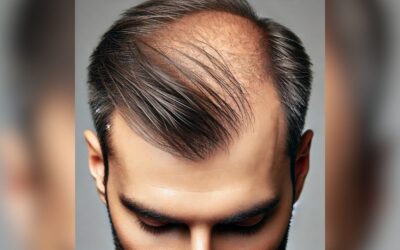What Is PRP?
PRP (or Platelet Rich Plasma) is a non-invasive injectable treatment that uses a patient’s own blood plasma. A small blood sample is drawn from the patient in a specialized tube. It is then placed in a centrifuge for ten minutes.
While it’s in there, the tube is rapidly spun to separate the plasma from red blood cells. The separated plasma contains the PRP. Finally, this solution is injected into the scalp.
How Does PRP Work?
In terms of hair loss, Goldenberg says that the plasma serves as sustenance for dormant hair follicles. “[It] supports the current hair follicles and then it promotes growth for the follicles that are in the scalp that aren’t able to grow because they don’t have enough nutrition,” he explains.
The growth factors found in PRP are known to produce the following effects:
- Epidermal Growth Factor: Regulates cell growth by stimulating keratin and fiber production.
- Transforming Growth Factor: Promotes the growth of new blood vessels.
- Vascular Endothelial Growth Factor: Stimulates the growth of blood vessels from the existing vasculature.
- Fibroblast Growth Factor: Promotes granulation during tissue repair.
- Platelet-Derived Growth Factor: Promotes collagen growth and proteoglycan synthesis while also attracting macrophages and fibroblasts to the treated area.
- Collagen Stimulating Growth Factor: Stimulates granulocyte and macrophage proliferation for the growth of healthy tissue and blood cells.
- Keratinocyte Growth Factor: Keratinocyte migration, differentiation and proliferations may optimize conditions for healing and generation of new skin.
- Interleukins, Macrophages, Keratinocytes, Endothelial Cells, Lymphocytes, Fibroblasts, Osteoblasts, Basophils, and Mast Cells: Activate fibroblast differentiation and also induces collagen and proteoglycan synthesis for healthy cell production and repair of damaged tissues.
How Does PRP Differ from Traditional Hair Transplants?
While hair transplants have gained popularity for their instant results, PRP is less expensive upfront and is a non-surgical option that requires patience (PRP will, on average, cost around $400 or more per session, whereas hair transplant surgery can run anywhere from $7000 to $15000 for the full procedure). Green notes that PRP is a less painful process and that downtime isn’t necessary.
The Ideal Candidate
Patients who are experiencing hair loss with intact hair follicles are good candidates for PRP. These people may have excessive shedding, but they aren’t completely bald.
The sooner a person comes in to address their hair loss, the better their results will be. Both men and women are good candidates; however, the timing factor usually plays a role according to Goldenberg. In his experience, men seek treatment when balding has begun to set in while women seek treatment right away because they tend to consider hair loss an emergency.
Aside from severe baldness, there are few other conditions patients should be aware of before getting PRP done. According to Green, “PRP is safe for the vast majority—however, if you have any blood or platelet disorders; active infections or viral outbreaks such as shingles, or are on steroid treatments or blood thinners such as Coumadin, you should not have a PRP treatment.”
She also advises women who are pregnant to wait until after they give birth to consider PRP.
How Many Sessions of PRP Do You Need to See Results?
Ultimately, it all depends on the severity of hair loss and treatment combination. Three to four sessions on a monthly basis tend to yield results, though It can take up to six months to see a serious transformation. To sustain results, maintenance treatments can be done quarterly.
Side Effects
Fortunately, there aren’t many known side effects of PRP. At most, patients may experience tenderness on the scalp after injections. Some patients may also report having a slight headache or pressure in the treated area. This discomfort can be relieved with a basic pain killer.
Aftercare
Since PRP is a non-invasive treatment, there is no downtime. Many are even able to go about their daily activities immediately following treatment. However, there’s a list of factors that you should steer clear of during recovery:
- Avoid water and heavy exercise for the first 24 hours following treatment
- Refrain from using hair care products for 24 hours
- Limit sun exposure to the treated area for 48 hours
- No harsh chemicals, hair coloring, or perming 72 hours
- Do not drink alcohol and/or smoke for 72 hours
- Avoid anti-inflammatory medications for five days after your procedure, if possible
- No blood-thinning agents for at least one week after your treatment
How Many Times Can You Get PRP?
Both doctors acknowledge that with a lack of negative drawbacks and the procedure’s overall proven effectiveness, there is no limit to the number of treatments a person can have. However, in order for your results to last for the longterm, you’ll have to continue with PRP every year because it’s a treatment, not a cure.
Maintaining Results
Results from PRP treatments can be maintained by taking oral prescriptions designed to address hair loss. Additionally, taking over-the-counter vitamins in conjunction with a targeted topical cream and scalp-stimulating devices may help. Below are some supplements and treatments that may help:
- Viviscal: An over-the-counter vitamin supplement formulated with essential vitamins such as Biotin, Vitamin C, and B in addition to other propriety vitamins for improved hair growth and thickness.
- Nutrafol: A propriety over-the-counter blend of vitamins clinically proven to restore hair growth. It comes as an oral supplement or a topical solution. The nutrient formulation prevents the conversion of the male androgen hormones into DHT (dihydrotestosterone), also known as the cause for baldness.
- Finasteride: A prescription medication used for androgenetic alopecia (male pattern baldness). It addresses hair follicle shrinkage caused by DHT and lowers those levels in the scalp to promote new hair growth.
- Spironolactone: A prescription medication that treats hormone imbalances in women.
- Minoxidil: A topical treatment applied to the scalp at bedtime. Longterm use helps to sustain results and minimize hair loss.
- LaserCap: An at-home FDA approved device that uses low light therapy to stimulate hair follicles.
A PERMANENT HAIR LOSS SOLUTION
If you suffer from male pattern baldness, thinning hair, patchy baldness, alopecia, or a receding hairline, the team at Best Hair Transplant in Redondo Beach is ready to take your call. At Best Hair Transplant, you will learn about the options that we offer and the various methods we use to get your hair back. You’ll receive a high-quality hair transplant for a great price; all without sacrificing quality.
WE TAKE PRIDE IN OUR WORK
If you’re one of the 80 million Americans suffering from hair loss, the regenerative medical team at Best Hair Transplant suggests learning as much as possible about hair restoration prior to making a decision on how to address your hair loss. Not every procedure is right for everyone.
That’s why at Best Hair Transplant in Redondo Beach, we pride ourselves in helping our patients choose the best procedure for them. For your benefit, ask to see “Before & After” photos.
At Best Hair Transplant, we’re proud of our results and happy to provide them. Additionally, it’s always a good idea to look into the patient experience. Reviews and testimonials from Best Hair Transplant’s vast assortment of satisfied clients can be viewed HERE.
YOUR HAIR LOSS SOLUTION
Best Hair Transplant
1970 S. Prospect Ave., Suite 2
Redondo Beach, CA 90277
(213) 403-0455











